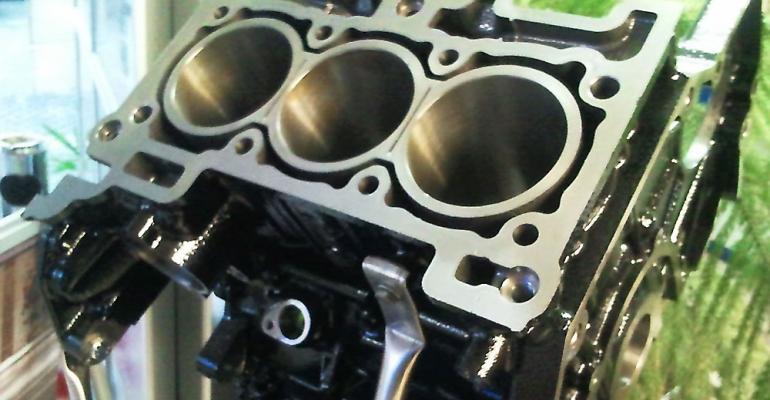NEW YORK – Ford sets a new paradigm in engine downsizing in the U.S. market, offering the 1.0L 3-cyl. EcoBoost engine as an option in the ’15 Fiesta. It's the smallest powerplant available in the U.S. from any vehicle manufacturer.
Despite its high fuel efficiency rating, only 4% to 8% of Fiesta customers in the U.S. select the model with the 1.0L mill. However, that’s in line with Ford's modest sales targets, says Wade Jackson, Fiesta marketing manager. The take rate is markedly higher in 72 other Ford markets globally.
For instance, in Europe’s 19 markets, the l.0L engine accounts for 40% of B-Max sales, 30% of Focus sales and 25% of Fiesta sales. The 1.0L will become available in the Focus later this year in the U.S. Ford declines to comment on further applications in this market.
The 1.0L powerplant is a sign of a growing engine-downsizing trend as automakers seek to boost CAFE ratings and more motorists seek relief from climbing gasoline prices. In other countries, notably Japan, tiny cars with even smaller-displacement engines are common. But Western countries generally see engines downsized more modestly.
The Fiesta is the top-selling subcompact brand globally, handily outselling the Honda Fit and Toyota Yaris, its top competitors in the segment. Subcompacts appeal to thrifty buyers who watch their fuel expenditures carefully, and Ford believes its new mini-engine will fulfill consumers’ expectations.
The automaker claims the Fiesta's 1.0L engine's 36 mpg (6.5 L/100 km) combined city/highway fuel economy is the best of any non-hybrid vehicle sold in the U.S.. However, some diesels may exceed that mark.
Ford manufactures the 1.0L mill at plants in Cologne, Germany, and in Craiova, Romania. Each plant has annual capacity of 300,000 units. Ford recently opened a factory in Chongqing, China, that is scheduled to produce about 70,000 1.0L engines this year.
The 1.0L engine gets its power boost from a turbocharger that Ford developed in collaboration with supplier Continental. Spinning at up to 248,000 rpm, the EcoBoost charger doubles the rpm of current Formula 1 race car engines.
All Fiestas with 1.0L engines sold in the U.S. come with a manual transmission. Overall, about 25% of Fiesta buyers opt for manuals, one of the highest take rates for any Ford model.
For the time being, Ford is the global leader in 1.0L engines. Daimler uses a 1.0L powerplant in the Smart car. Volkswagen, Peugeot and Renault offer, or are in the process of developing, 1.0L mills for European vehicles.
General Motors uses a 1.0L engine in the Opel Adam for the European market. The automaker does not confirm news reports saying that engine will be brought to the U.S. for use as the range-extending powerplant in the next-generation Chevrolet Volt debuting next year.
No plans to use the even-smaller engines such as those found in Japanese minicars in cars sold in the U.S. are in the works. But the 1.0L engine may become even more common as automakers strive to meet increasingly stringent fuel-economy standards.





